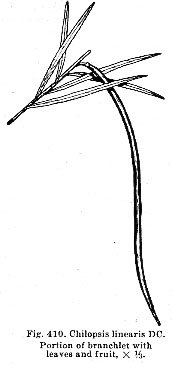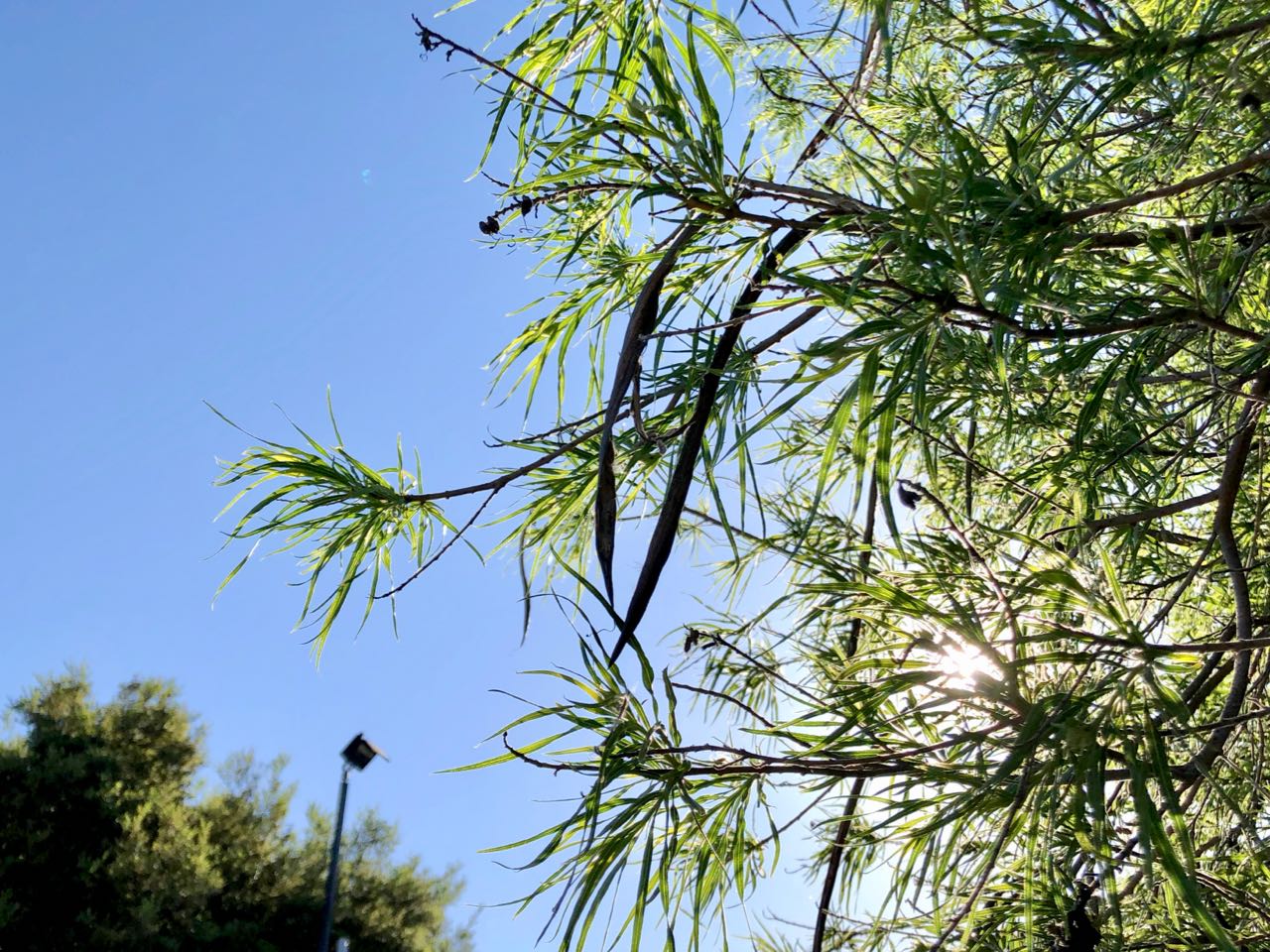Chilopsis linearis
 desert willow
desert willow

A small deciduous tree with hanging, sharp-pointed seed pods about 10 inches long by ¼ inch diameter, with two short bracts. As with catalpa, the pod splits to reveal a stiff divider about ⅛ inch wide. The very narrow leaves are 3 to 4 inches long by less than ¼ inch wide. There are well over 50 of the tiny kernels, which are only about ⅛ inch long and concealed in a hair-fringed shell about an inch long. The kernels can be located by crushing on paper which, when held up to the light, will reveal a tiny oil spot. The attractive flowers, resembling those of both the catalpa and jacaranda, hang as 1½-inch-long trumpets. One of the five wavy-edged lobes of the trumpet appears to be designed as an insect landing strip. The four hard-to-find anthers are tucked away inside.
Two remain of several street trees west of the entrance to 1047 Campus Drive (formerly ΣΑΕ house). See three much more full-canopied trees in what used to be the back of the old Children’s Center at 685 Pampas Lane, currently in front of the tall fence (map pin). With the construction of the new building at 560 Fremont Road in 2024 came a fresh planting of this species, in front of the building, on the left.
The dissection of a desert willow pod would be fun for school children and could lead to a discussion of the hairiness (in-pod insulation? or aid in dispersal by wind? or something else?); the canoe shape (slows the fall? or makes a protective tent for a fallen kernel?); why is the pod so long and why does it hang on the tree for so long (for protection against some pest? or for slow release of seeds to guard against infrequent showers of rain in the desert?); what is the function of the divider (stiffen the 8-inch-long pod? or is it merely a relic of a primitive two-celled ovary from times before the pod evolved to today’s extreme length?). Such class discussion following a field trip would promote environmental awareness and also exemplify Galileo’s theme that knowledge can be obtained directly from nature by experiment as well as from people.
Chitalpa tashkentensis, a cross of desert willow with Catalpa made in the USSR in the 1960s, is popular in horticulture. It is available only in two clones, ‘Pink Dawn’, with pinkish flowers, and ‘Morning Cloud’, with white flowers. The catalpa parent was thought to be C. bignonioides when the name Chitalpa tashkentensis was first published in 1991. A molecular study in 2006, however, determined that the catalpa parent of ‘Pink Dawn’ may be a hybrid of Catalpa speciosa and C. ovata, and that of ‘Morning Cloud’ is C. speciosa. Thus, there may be taxonomic changes to deal with this situation.
The only specimens known at Stanford are a pair of ‘Pink Dawn’ at 813 Cedro Way, at the corner, in front of a pineapple guava hedge. They bloom for months on end in the summer. In Palo Alto, see more ‘Pink Dawn’ in planting beds in front of 201, 206, and 480 California Avenue, and as the curbside tree at 2147 and 2149 Yale Street.
Illustrations: Chilopsis linearis: silhouette from Trees of Stanford & Environs | flower.
Name derivation: Chilopsis – from Greek cheilos (lip) and opsis (resembling), referring to the corolla of the showy flower; linearis – lined (the purple lines in the flower throats).
About this Entry: The main text of this entry is from the book Trees of Stanford and Environs, by Ronald Bracewell, published 2005. John Rawlings added the Children’s Center location. Location updates; all locations verified (Apr 2020, SP). 560 Fremont location added, Chitalpa notes and locations added (Jan 2025, SP).





